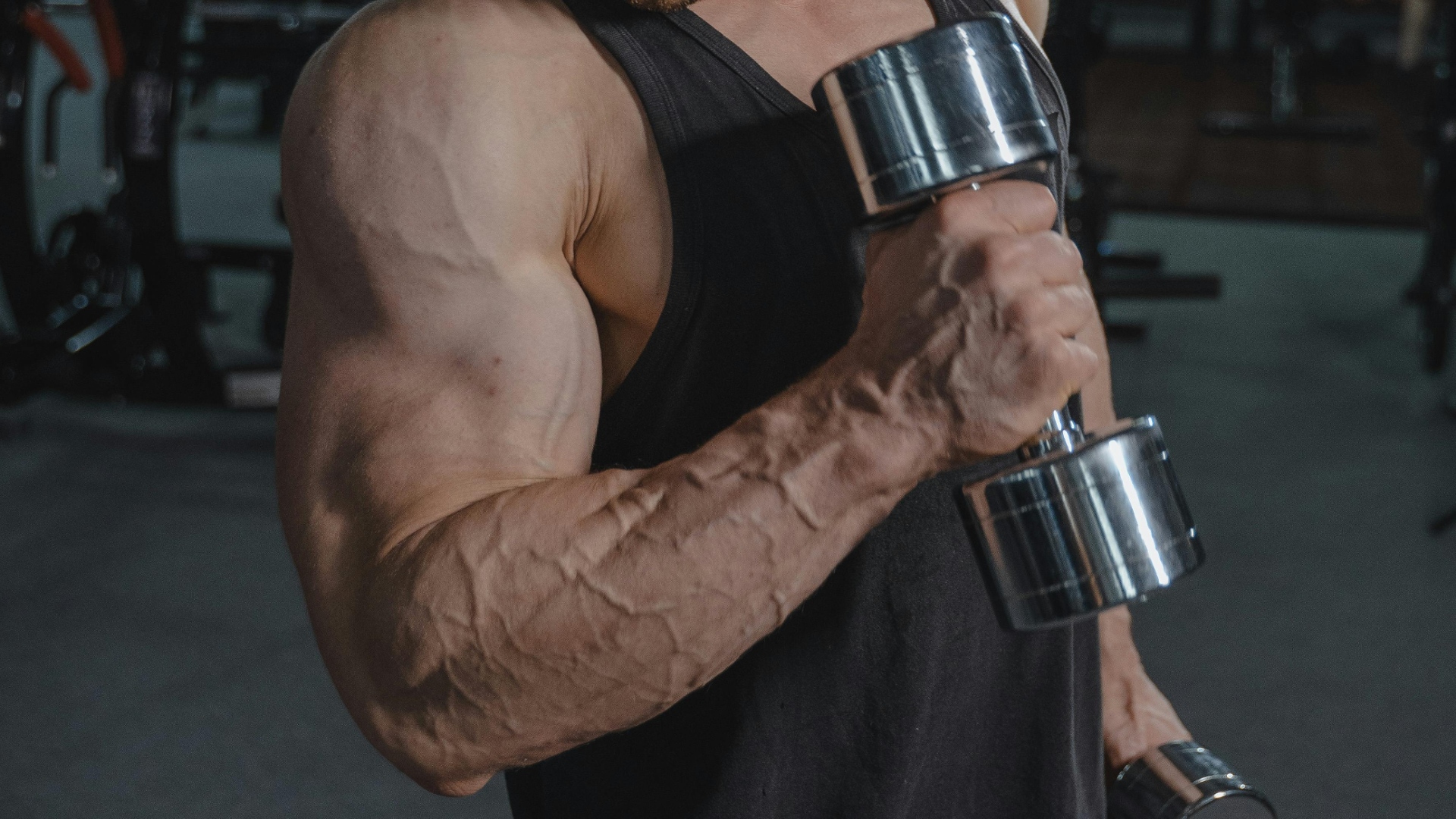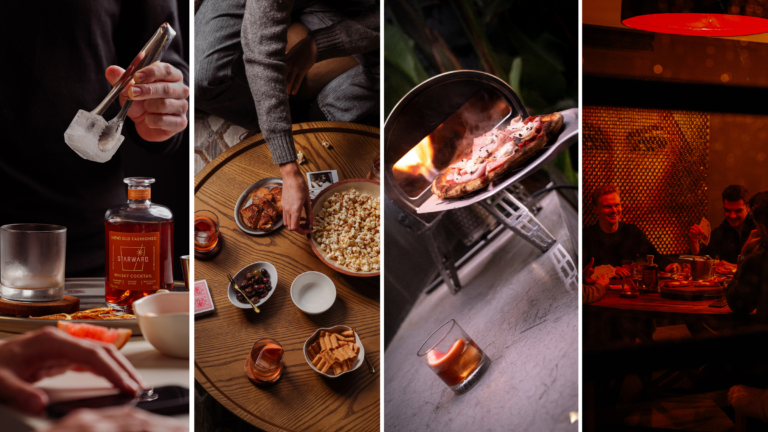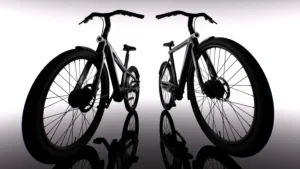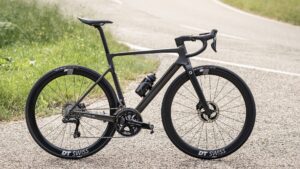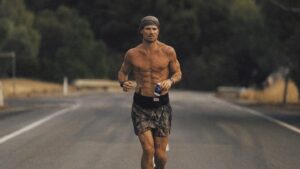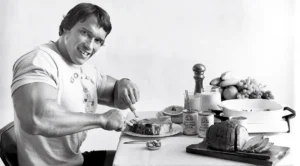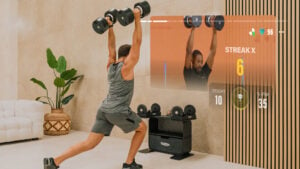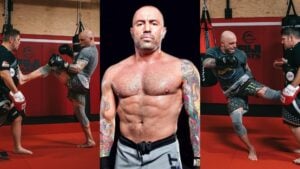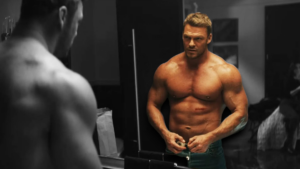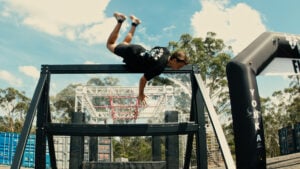Every man who exercises — and even men who don’t — knows a little something about the big muscle groups. With exercises like the bench press, deadlifts, and squats, you’re probably thinking about the hero muscles — your biceps, quads, glutes, pecs, and abs. However, forearm strength and learning the best exercises for them is critical to ensure you’re developing your strength in a well-rounded way.
Most men only focus on the large muscle groups because they’re easier to understand and offer the feeling of quicker improvements, but without strong forearms, you’ll never be able to realise the full potential of your upper arms and torso. Think about it, you can’t bicep curl a heavy dumbbell if you don’t have the forearm strength to pick the weight up, and the same goes for deadlifts and many more exercises.
Stronger forearms mean better grip strength and without good grip strength, you’re only limiting yourself in what you can achieve. To get the best results while you’re in the gym, you need to know what the best forearm exercises are, so we pulled together ten of our favourites for your next visit to the Iron Temple.
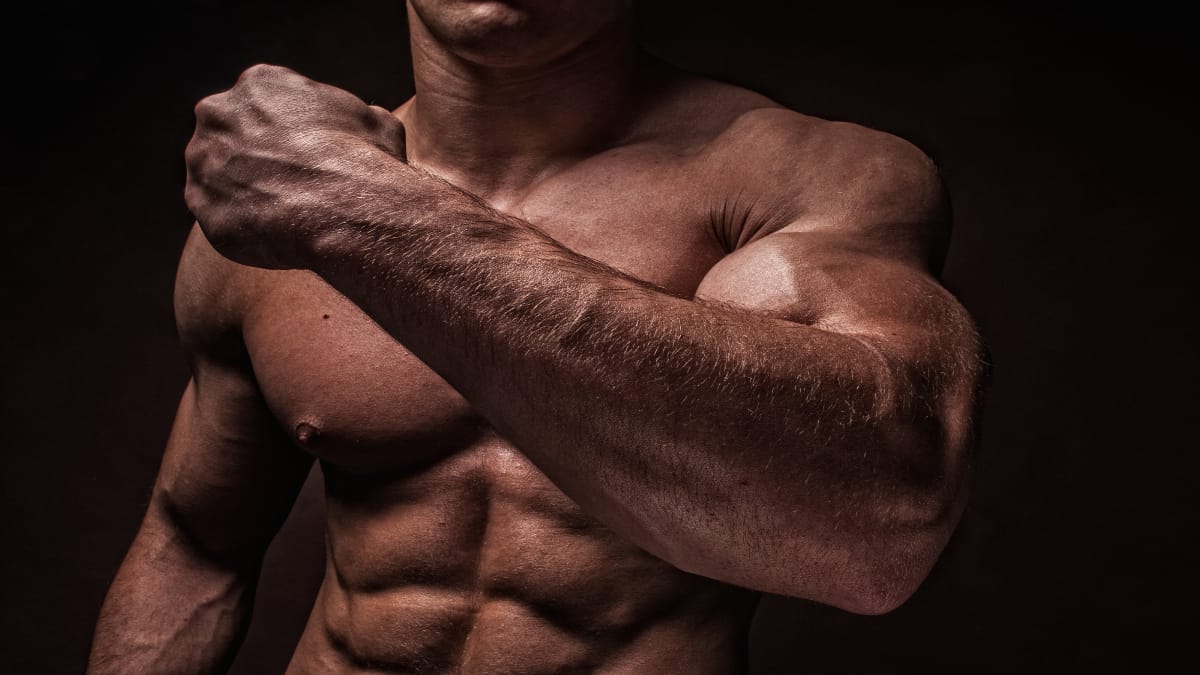
Jump To:
What Are The Different Forearm Muscles?
Whenever you’re training any muscle group, it’s always a good idea to get at least a basic grasp of its anatomy. The more you know, the smarter you can train. Let’s look at the forearm as a muscle group.

The forearm has more individual muscles than any other large muscle group (1), which all have complicated Latin names like the extensor carpi radialis longus, flexor carpi radialis, extensor carpi radialis brevis, flexor digitorum superficialis, flexor carpi ulnaris and extensor carpi ulnaris. To put it more simply, there are a total of 20 muscles (1), which are categorized into three different layers:
- Superficial
- Intermediate
- Deep
Some experts will also divide the forearm into the anterior compartment and posterior compartment, or in other words, the inner arm and outer arm. In simplest terms, the anterior (the inner arm) muscles are the wrist and finger flexors, which allow you to bend your fingers. This portion of flexor muscles also contains the well-known carpal tunnel.
The posterior (the outer arm) muscles include the wrist extensor muscles, which are responsible for extending the fingers and the wrist. Both the anterior and posterior portions of the forearm contain superficial, intermediate, and deep muscles.
Why Are Forearm Exercises & Workouts Important?
When you understand how the forearm muscles operate and what they do, you quickly realise that they are vital in training the upper body and, in some cases, the lower body. Basically, the stronger your forearms are, the better your grip strength will be (2).
Just think about how critical your grip strength is to your overall training. If you want to curl heavy dumbbells, you need strong forearms. You need excellent grip strength if you’re going to max your deadlift personal record.
You may build your back and shoulder blades enough to handle 100 pullups, but you’ll never hang on long enough to get there if you have poor grip strength. In short, forearm strength is one of the many crucial building blocks to a strong, well-rounded physique.
Last, but certainly not least is a little secret tip that improves your muscular blood flow and the grip strength of your forearms, all without making the workout any more complicated. Using fat grips on your dumbells, barbells, and cable machine handles during your workout gives you the benefit of recruiting more muscle fibres into each rep, increasing your grip strength which will help you lift heavier weights.
How To Get Bigger Forearms
If you’re after bigger forearms, the muscle you want to be paying the most attention to is the brachioradialis.
It isn’t technically part of the forearm musculature as it begins in the upper arm and doesn’t cross the wrist joint, meaning it doesn’t help to move your hand in the same way your true forearm muscles do. However, it does help brace your elbow to produce maximal force through your wrist, so the best way to build its strength and size is through workouts that flex the elbow joint.
The Top 10 Best Forearm Exercises For Strength & Stamina
Now that we’ve gotten through the specifics, we can get to the good stuff: the best forearm exercises. That’s why you’re here, after all.
Below we have ten different forearm workouts that will help you train and strengthen your forearms. Not only can these forearm exercises help you improve grip strength, but they can also give you a more toned and muscular appearance with time and consistency.
1. Palms-Up Wrist Curls
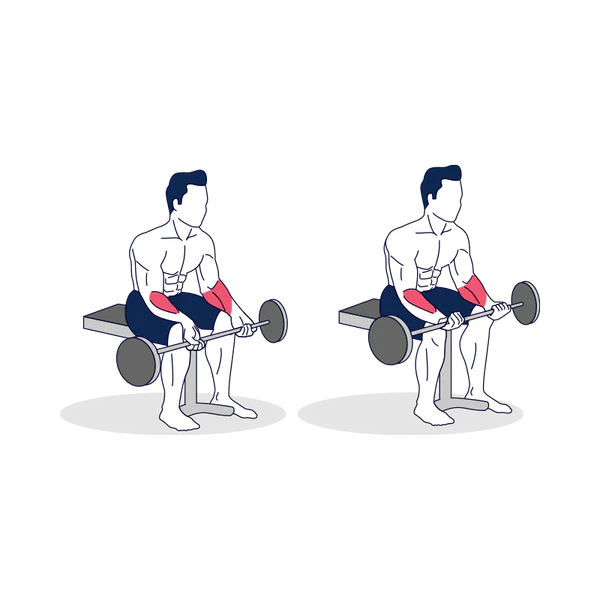
- Difficulty: Beginner
- Target muscles: Interior forearms, biceps
- Equipment needed: Dumbbells
- Sets: 2-4
- Reps: 10-12
- Rest: 30 seconds
Benefits: A palm-up wrist curl is one of the simpler forearm workouts that require minimal equipment, and no complicated movements. All you need for these dedicated forearm exercises is a set of dumbbells and either a chair or a bench.
How to Do It:
- Sit on the bench or chair with both feet planted flat on the ground, forming a 90-degree angle at the knee.
- With a dumbbell in each hand, rest your wrists on your knees and your outer forearm on your thighs, palms facing up.
- Slowly raise both hands towards your inner forearm without lifting your wrist from your knees. Flex them as far as possible, pause briefly, and then slowly release them back down. That’s one rep.
2. Palms-Down Wrist Curls

- Difficulty: Beginner
- Target muscles: Exterior forearms, biceps
- Equipment needed: Dumbbells
- Sets: 2-4
- Reps: 10-12
- Rest: 30 seconds
Benefits: A palm-down wrist curl is similar to a palms-up wrist curl, except you turn your wrists so that your palms are now facing down. This forearm exercise works the outer muscles of your forearm, while the palms-up variation focuses on the inner muscles. You will need two dumbbells and a chair or a bench for this exercise.
How to Do It:
- Sit on the bench or chair with both feet planted flat on the ground, forming a 90-degree angle at the knee.
- Take a dumbbell in each hand and place the inner part of your arms on your thighs with your wrists on your knees.
- Slowly raise your hands as high as you can, flexing at the wrist without lifting your arms from your legs. Pause briefly before slowly releasing back down. That’s one rep.
3. Farmer’s Carry
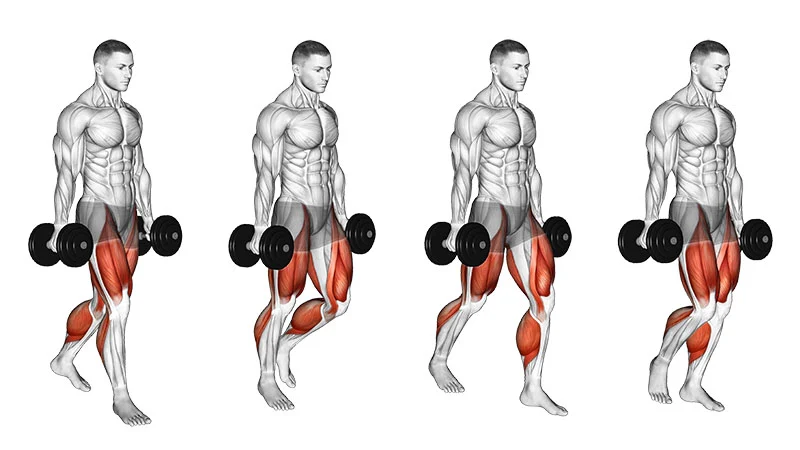
- Difficulty: Beginner
- Target muscles: Whole body workout
- Equipment needed: Dumbbells or kettlebells
- Sets: 2-4
- Reps: 20-30 Steps
- Rest: 30 seconds
Benefits: The farmer’s carry is a very common workout often geared towards overall body stability, as it helps you develop a stronger core (3). This workout also lets you work on your forearm strength by challenging your grip. It’s easy to perform and requires a set of heavy dumbbells or kettlebells.
How to Do It:
- Grip a heavy dumbbell or kettlebell in each hand with your arms straight and stand up straight as your starting position.
- Brace your core, chest, and shoulders, and begin walking towards your desired endpoint, maintaining good posture with your shoulders back and gripping the weights tightly.
- An alternative that engages your core more acutely is the single-arm farmer’s carry, where you perform the same walk holding good posture, but with a single dumbbell or kettlebell in your hand. Once you’ve performed the exercise on one arm, do it again holding the weight in the other hand.
4. Trap Bar Carry
- Difficulty: Intermediate
- Target muscles: Whole body workout
- Equipment needed: Trap bar
- Sets: 2-4
- Reps: 20-30 Steps
- Rest: 30 seconds
Benefits: The trap bar carry is a variation of the farmer’s carry, which is incredible for forearm strength training. Unlike dumbbells and kettlebells which have very limited weight ranges a trap bar will allow you to increase your weight exponentially, pushing your limits.
How to Do It:
- Load your trap bar with your desired weight.
- Stand inside the bar and grip the handles, standing straight up into the starting position.
- Bracing your core, chest, and shoulders, begin walking according to your workout structure. Maintain a good grip and tall posture as you walk.
5. Plate Pinches
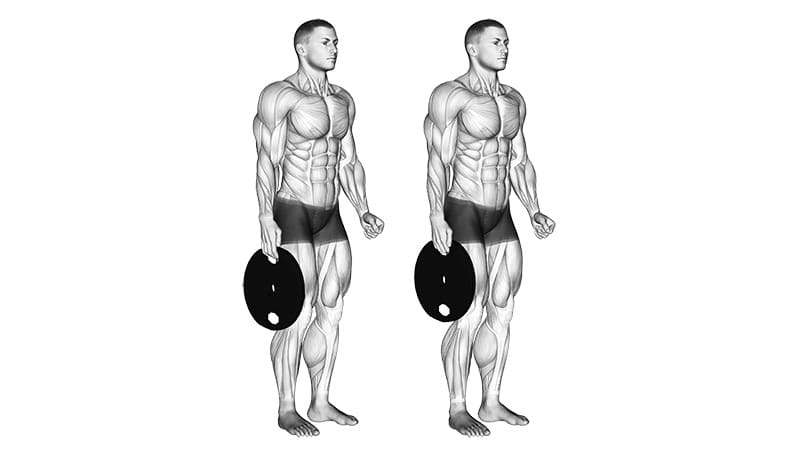
- Difficulty: Intermediate
- Target muscles: Forearms, biceps, triceps, deltoid
- Equipment needed: Barbell weight plate
- Sets: 2-4
- Reps: 20-30 seconds
- Rest: 60 seconds
Benefits: Plate pinches are not only excellent for training your forearms, but they also help build strength in smaller muscles like your fingers and thumbs. All you need is a weight plate to improve your pinch grip.
How to Do It:
- Choose a weight plate ranging from 10 to 15 kg.
- Stand upright and hold the plate at your side, elbows tucked and slightly bent, using just your fingers.
- Hold the plate by your side for 20-30 seconds.
- Swap arms and repeat.
6. Backwards Cable Curl

- Difficulty: Intermediate
- Target muscles: Forearms, biceps, triceps
- Equipment needed: Cable machine or barbell
- Sets: 2-4
- Reps: 10-12
- Rest: 60 seconds
Benefits: The backward cable curl or reverse curl is the perfect workout to add to your bicep or pull day if you have access to a barbell or cable machine. Not only does this exercise work the bicep, but it also thoroughly engages the outer forearms to tone and strengthen both at once.
How to Do It:
- Using a single handle attachment on a low cable pulley, grab hold with your back to the machine and take a few steps forward.
- Position one foot directly underneath you and the other staggered slightly behind you until you’re in a stable starting position.
- Start with your arm angled slightly behind you and slowly curl your arm, bringing your hand to your shoulder.
- Pause at the top before slowly releasing down again. This is one rep.
7. Bottoms Up Clean to Rotation
- Difficulty: Intermediate
- Target muscles: Forearms, biceps
- Equipment needed: Dumbbells or Kettlebells
- Sets: 2-4
- Reps: 10-12
- Rest: 60 seconds
Benefits: The bottoms-up clean-to rotation is one of the best forearm exercises to spice things up a little bit, as it also engages your core and requires some thoughtful coordination. What you’ll need is a set of small kettlebells or dumbbells.
How to Do It:
- Place both knees on the ground, positioning your spine straight and your core tight.
- Grip one kettlebell or dumbbell in each hand and let them hang at your sides.
- Swing the weights slightly backward, bending slightly at the hips, and then use your arms and momentum to bring the weights forward, and upward, bending at the elbow while your elbow is kept tucked close to your torso.
- Keep your wrists straight and lift until your elbows reach the 90-degree point and the kettlebell upside down with palms facing forward. Your triceps should be parallel to the ground with your forearm in a vertical position and weights balanced at the top near your face.
- Pause at the top of each clean for one second, rotate your wrist in and out, and then let your arms drop into the next clean rep.
8. Pull Up Bar Hang
- Difficulty: Intermediate
- Target muscles: Forearms, lats
- Equipment needed: Pull-up bar
- Sets: 2-4
- Reps: Till failure
- Rest: 60 seconds
Benefits: A pull-up bar hang is another one of the best forearm workouts because it’s straightforward and builds isometric arm strength, as well as focuses on increasing the stamina of the muscle group. They also benefit your lat muscles, so you can tack them onto any arm or back workout.
How to Do It:
- With your arms and hands shoulder-width grip apart, grab hold of a pull-up bar using an overhand grip. A shoulder-width grip is essential to getting the most out of the exercise.
- Hang on the bar without wrist flexion, arms fully extended and feet off the ground, for as long as you can.
- Try to hang a little longer with each effort.
9. Hammer Curl
- Difficulty: Intermediate
- Target muscles: Forearms, biceps
- Equipment needed: Dumbbells
- Sets: 2-4
- Reps: 10 per arm
- Rest: 60 seconds
Benefits: The hammer curl is simple to perform because of its innate similarity to standard bicep curls for the upper arms. However, this exercise is best for adding to any bicep or upper body workout, as it works both the upper arms and the forearms.
How to Do It:
- Hold a dumbbell in each hand, and turn your wrists inward to face each other.
- Stand with your legs hip-width apart and arms close to your sides. Your elbows should be under your ribs.
- Perform alternating curls in this position, bringing the dumbbell up to your shoulders by bending at the elbow and flexing the bicep.
- Pause briefly at the top of the rep and slowly return the dumbbell to your side. This is one rep.
10. Towel Pull-Up
- Difficulty: Advanced
- Target muscles: Forearms, biceps, triceps, traps
- Equipment needed: Pull-up bar, towel
- Sets: 2-4
- Reps: Till failure
- Rest: 60 seconds
Benefits: Pull-ups themselves test and train your grip strength and forearm strength, but adding a towel increases the difficulty and challenges your forearm muscles further.
How to Do It:
- Wrap a long bath or beach towel and loop it over a pull-up bar.
- Grip the towel with both hands around the middle.
- Perform a pull-up while gripping the towel, focusing on slow movements and maintaining a solid grip.
Final Thoughts
Although forearm strength is essential to most of the workouts we perform regularly, it often gets forgotten. Your forearms will naturally receive a workout anytime you engage them, but targeted training can help you improve grip strength and the appearance of your upper arm too. Incorporate a few of these best forearm exercises into your routine to reach your fitness goals.
Citations
- Anatomy, Shoulder and Upper Limb, Forearm Muscles, National Library of Medicine, 14 June 2022
- The Importance of Forearm Strength and How to Build It, Scientific American, 1 October 2019
- The real-world benefits of strengthening your core, Harvard Health Publishing, 24 January 2012
The Boss Hunting Fitness Reviewer — Jono Castano, Certificate IV in Fitness, Precision Nutrition Level 1
Jono Castano is a Sydney-based celebrity personal trainer and certified nutrition coach who specialises in fitness, training, workouts and diet plans. He is the co-founder of the popular Acero fitness brand and fitness app and has become well-known for his extensive work with noted figures like Rebel Wilson, Jessica Mauboy, Lincoln Lewis, Joel Creasy, and The Veronicas.
Jono has built a large social media following with over 800,000 subscribers on Instagram. He has also been profiled by publications such as Men’s Health and has become one of the most recognisable fitness instructors in Australia.
- Location: Sydney, Australia
- Credentials: Certificate IV in Fitness, Precision Nutrition Level 1
- Expertise: Fitness, Training, Personal Training, Workouts, Diet Plan
Editor’s Note: The fitness content on Boss Hunting is informative in nature, but it should not be taken as medical or professional fitness advice. When starting a new training regimen and/or diet, consulting with a trusted medical professional or trainer is always a good idea.
Did you enjoy this article on the best shoulder exercises? Check out a few of Boss Hunting’s other workout guides below:
- The 15 Best Exercises For The Perfect Leg Workout
- The 12 Best Shoulder Exercises For Improved Strength & Size
- The 15 Best Exercises For The Perfect Leg Workout
- The 16 Best Chest Exercises & Workouts For Men
- How To Bench Press [A 101 Guide For The Average Bloke]
- The 21 Best Rear Delt Exercises For Boulder Shoulders
- The 11 Best Tricep Exercises For Improved Strength & Size
- The 15 Best Bicep Exercises & Workouts For Men
- The 15 Best Ab Workouts & Exercises For Summer
- The 9 Best Lat Exercises For Improved Strength & Size
- The 16 Best Oblique Exercises & Workouts For Men
- The 13 Best Trap Exercises & Workouts For Men
- 5 First Time Marathon Tips From Olympic Runner Brett Robinson
- The 25 Best Dumbbell Exercises & Workouts You Don’t Need A Gym For
- Why The 75 Hard Challenge Can Work For You
For more information to consider about diet, nutrition and, fitness equipment, check out below:
- Does Intermittent Fasting Actually Work? We Tested It Out
- How To Lose Weight Fast: 10 Simple Tips To Shed Fat More Efficiently
- The 7 Best Massage Guns You Can Buy In Australia
- The 13 Best Exercise Bikes To Stay Fit This Winter
- The 22 Best Mountain Bikes Money Can Buy Right Now
- The 16 Best Electric Bikes In Australia
- 8 Best Tennis Shoes for Men in Australia
For some celebrity inspiration, check out our celebrity workout guides right here:
- Henry Cavill’s Workout Routine Will Unleash Your Inner Superman
- The Workout That’ll Get You ‘Gladiator 2’ Ripped Like Paul Mescal
- The Chris Hemsworth Workout & Diet Plan Is Inhuman
- Jake Gyllenhaal’s Workout & Diet Plan To Get ‘Road House’ Ripped
- How Jeremy Allen White Got Calvin Klein Model-Jacked
- Joe Rogan’s Workout & Diet Plan Isn’t For The Faint-Hearted
- How Hugh Jackman Trained For His MCU Return In ‘Deadpool & Wolverine’
- Daniel Craig’s Military-Inspired Workout For ‘No Time To Die’
- How Michael Jordan’s Personal Trainer Helped Him Achieve GOAT Status
- The Bruce Lee Workout That Made His Rig Famous
- The Rock’s Intense Workout For ‘Hobbs & Shaw’ Will Bring You To Your Knees
For the best places to improve your health and fitness, check out our recommendations here:
